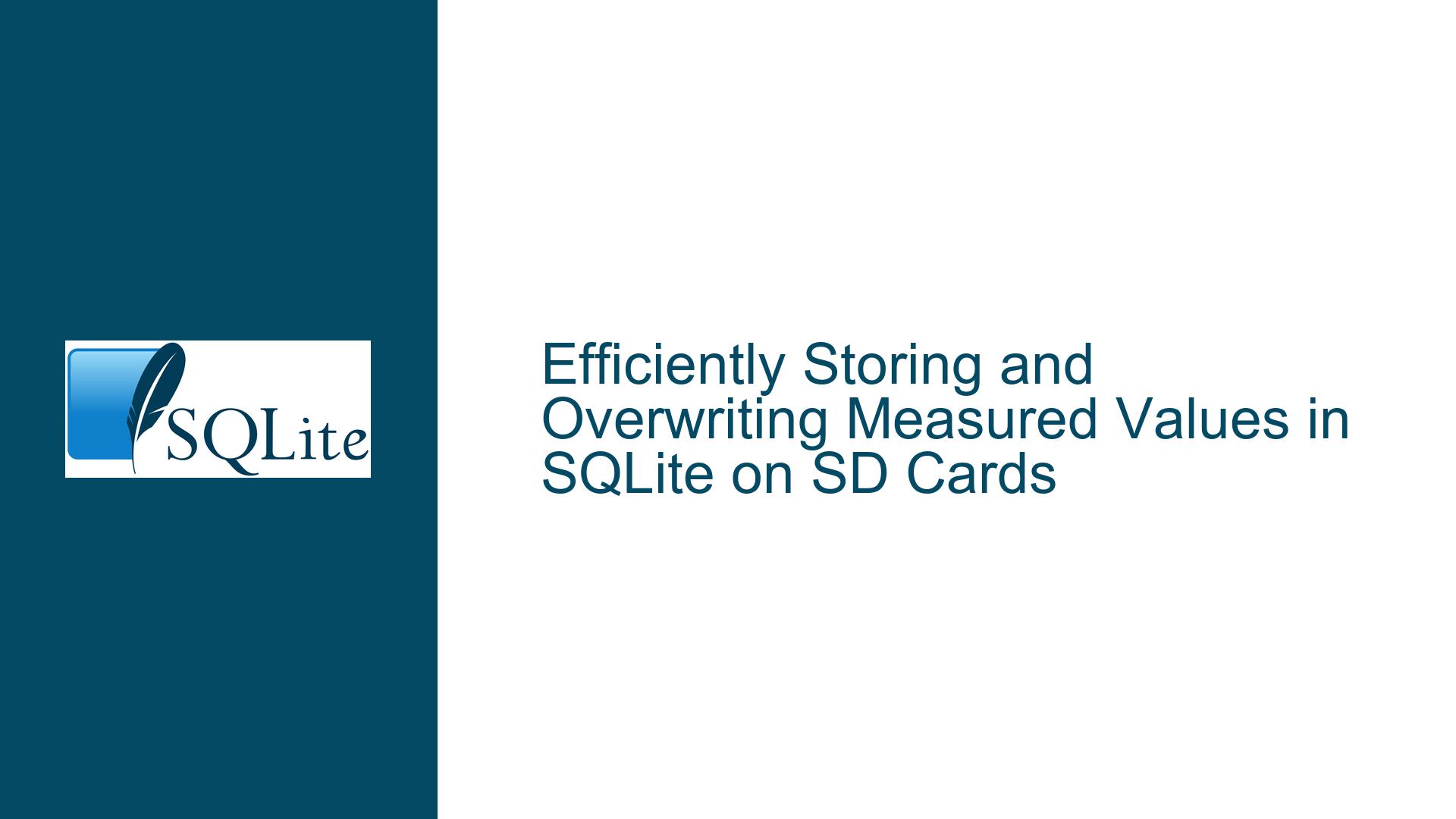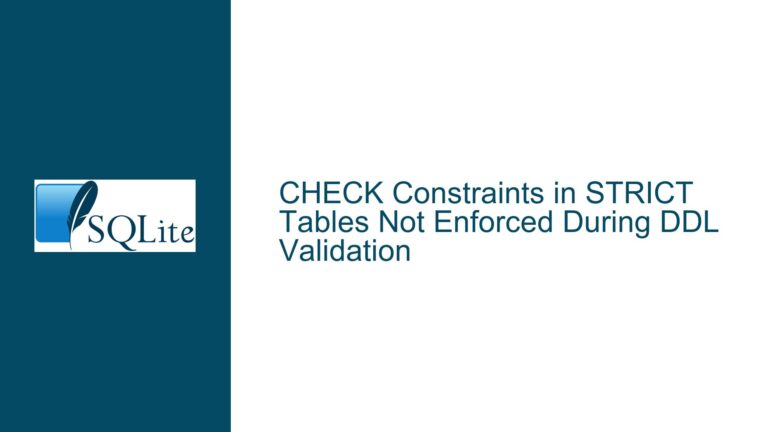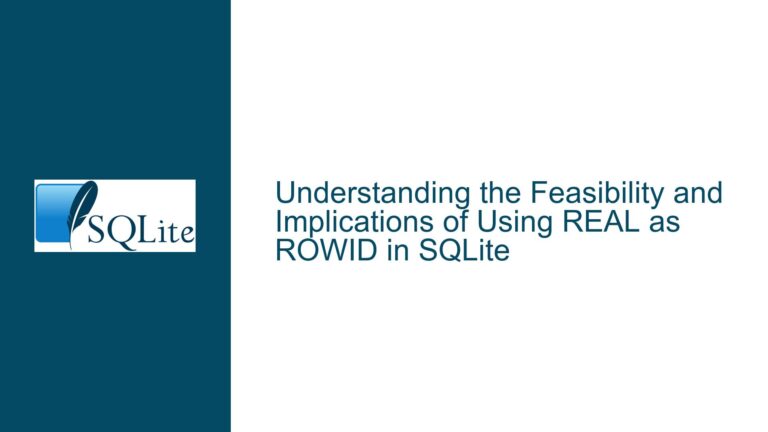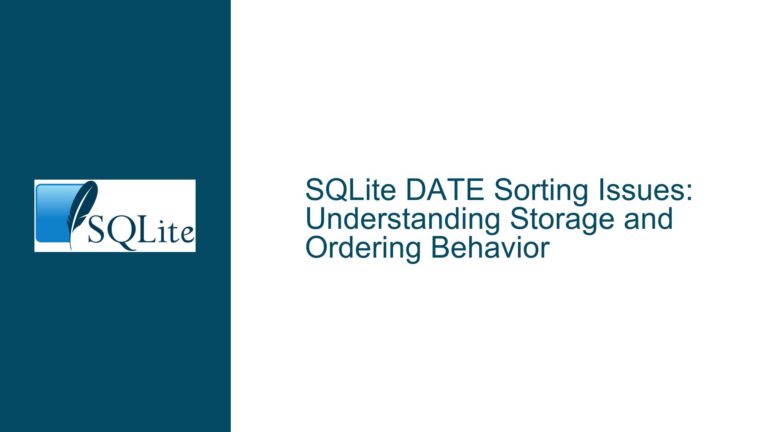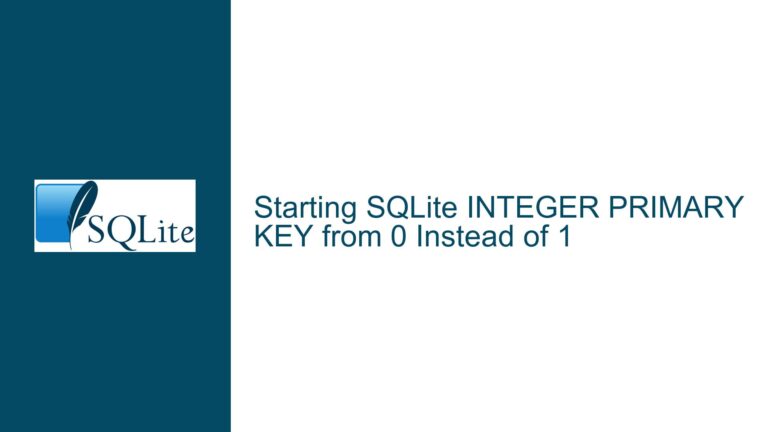Efficiently Storing and Overwriting Measured Values in SQLite on SD Cards
Managing Measured Values with Overwrite Semantics in SQLite
The core challenge involves implementing a storage pattern where 150 sensor readings are persistently stored per measurement cycle while ensuring previous data is automatically purged or overwritten. This requires careful consideration of SQLite’s data manipulation capabilities, table structure design, and transaction handling. The primary objective is to maintain a fixed storage footprint despite continuous measurement cycles, preventing database file growth that would otherwise occur with naive append-only approaches.
A critical architectural decision revolves around whether to physically delete old records or update existing ones. Physical deletion via DELETE statements creates reusable space in the database file, but SQLite does not automatically shrink the file size unless explicitly vacuumed. In-place updates using UPDATE or REPLACE operations modify existing records, which may preserve overall file size but require careful key management to target specific rows. The choice between these strategies impacts not only storage efficiency but also write performance and SD card wear characteristics.
Table schema design must optimize for both write speed and query efficiency. A denormalized structure with a single table containing all measurement values as individual rows simplifies data retrieval but introduces overhead for managing 150 distinct entries per cycle. Alternatively, a semi-structured approach using JSON or BLOB storage for all 150 values in a single row reduces row management complexity but complicates partial updates and external processing. Primary key selection is paramount: using an auto-incrementing integer as a synthetic key allows trivial insertion but complicates overwrite logic, while a natural key based on measurement identifiers enables direct replacement semantics.
SD Card Wear Leveling and Database Configuration Considerations
SD card longevity concerns stem from the finite program/erase cycles of NAND flash memory cells. While modern SD cards implement wear-leveling algorithms in their firmware to distribute writes across physical blocks, database write patterns can still influence wear characteristics. SQLite’s page-oriented storage engine interacts with the SD card’s block-based addressing through the operating system’s file system layer, creating a chain of indirection where logical writes don’t directly map to physical writes. However, suboptimal database configuration may exacerbate write amplification, indirectly affecting card lifespan.
Configuring SQLite’s page size to align with the SD card’s native erase block size (typically 4KB-8KB) minimizes partial-block updates. This is achieved via PRAGMA page_size = 4096; or similar during database creation. Journaling modes significantly impact write patterns: DELETE mode (SQLite’s default) doubles write operations by maintaining a rollback journal, while WAL (Write-Ahead Logging) mode batches changes more efficiently but requires managing separate WAL files. For append-heavy workloads, WAL generally provides better performance with lower wear impact.
The synchronous pragma controls how aggressively SQLite flushes writes to disk. PRAGMA synchronous = NORMAL; offers a balance between data integrity and write frequency, while PRAGMA synchronous = OFF; maximizes write speed at the risk of data corruption during power loss. For measurement systems with UPS backup or battery power, OFF may be viable to reduce SD card wear. However, the default FULL setting ensures maximum data durability at the cost of increased write operations.
Ensuring Data Consistency and Synchronization Between Processes
Concurrent access from measurement writers and data processors introduces race conditions where incomplete datasets might be read or overwritten mid-transaction. SQLite’s locking model provides coarse-grained control through database-level locks, but effective synchronization requires combining transactional boundaries with application-level coordination.
Exclusive write transactions (BEGIN EXCLUSIVE; … COMMIT;) guarantee atomic replacement of entire datasets by blocking readers during updates. For the 150-value measurement scenario, this ensures the processing application always sees either the complete old dataset or the complete new dataset, never a partial mix. However, exclusive locking introduces latency if processing occurs while new measurements are being written.
Temporal versioning augments raw data storage with metadata columns like timestamp INTEGER or generation INTEGER to enable optimistic concurrency control. Writers include the expected last-read version when overwriting values, allowing detection of concurrent modifications. Processors can cache the version identifier during read operations and verify it hasn’t changed before acting on the data.
Double-buffering techniques using two alternating tables (measurements_a, measurements_b) allow writers to populate one buffer while readers consume the other. A configuration table tracks the active buffer, which is atomically swapped via UPDATE buffer_config SET active = (active + 1) % 2;. This eliminates write contention entirely but doubles storage requirements—a manageable tradeoff given the small dataset size.
Troubleshooting Steps and Solutions
- Diagnose Write Amplification: Use
sqlite3_analyzertool to assess page utilization and fragmentation. High empty bytes per page indicate suboptimal packing, corrected byVACUUM;or schema redesign. - Benchmark Journal Modes: Compare
WALvsDELETEjournaling under realistic write loads usingtimecommands andiostatmonitoring. PreferWALif supported by SD card’s filesystem. - Implement Versioned Writes:
CREATE TABLE measurement_data (
sensor_id INTEGER PRIMARY KEY,
value REAL,
version INTEGER DEFAULT 0
);
Writers increment version on each update, allowing processors to detect changes via SELECT MAX(version) FROM measurement_data;.
4. Optimize Transaction Batching: Wrap the 150 REPLACE statements in a single transaction to minimize disk I/O:
with db_conn:
cursor = db_conn.cursor()
for sensor, value in measurements.items():
cursor.execute("REPLACE INTO measurements VALUES (?, ?)", (sensor, value))
- Monitor SD Card Health: Periodically check
smartctl -a /dev/sdX(if supported) for wear leveling counts and reallocated sectors. Rotate SD cards proactively in mission-critical deployments. - Enable Incremental Autovacuum: Configure
PRAGMA auto_vacuum = INCREMENTAL;and periodically runPRAGMA incremental_vacuum;during idle periods to reclaim space without full VACUUM’s write overhead. - Leverage Partial Indexes: If processing only recent data, create filtered indexes:
CREATE INDEX recent_values ON measurement_data(value)
WHERE version >= (SELECT MAX(version) - 10 FROM measurement_data);
- Validate Filesystem Alignment: Ensure the SD card is formatted with 4K sector alignment using
fdisk -land check forAlignment: alignedinmkfs.ext4output.
Schema Optimization Example
For fixed 150-sensor systems:
CREATE TABLE sensor_readings (
measurement_cycle INTEGER PRIMARY KEY,
sensor_values BLOB CHECK(length(sensor_values) = 150 * 8) -- 150 doubles
) WITHOUT ROWID;
Each cycle inserts a new row with all 150 values serialized as a BLOB, automatically overwriting previous data via primary key conflict. Processors deserialize the BLOB into an array client-side.
Concurrency Control Protocol
- Writer starts transaction, increments cycle number:
BEGIN IMMEDIATE;
INSERT OR REPLACE INTO sensor_readings VALUES (
(SELECT COALESCE(MAX(measurement_cycle), 0) + 1 FROM sensor_readings),
?
);
COMMIT;
- Processor reads latest cycle:
BEGIN DEFERRED;
SELECT sensor_values FROM sensor_readings
ORDER BY measurement_cycle DESC
LIMIT 1;
COMMIT;
This guarantees serializable isolation between concurrent readers and writers.
SD Card Endurance Calculation
Assuming:
- 150 values @ 8 bytes each = 1200 bytes/cycle
- 1 cycle/second = 43.8MB/year
- Typical SD card endurance = 100 TBW (terabytes written)
Lifespan = 100e12 bytes / 43.8e6 bytes/year ≈ 2283 years.
Thus, wear leveling is practically sufficient, rendering manual write distribution unnecessary.
Final Configuration Checklist
- [ ] Initialize DB with
PRAGMA page_size = 4096; - [ ] Enable
PRAGMA journal_mode = WAL; - [ ] Set
PRAGMA synchronous = NORMAL; - [ ] Create WITHOUT ROWID table for sensor data
- [ ] Implement application-level cycle version tracking
- [ ] Schedule weekly
PRAGMA wal_checkpoint(TRUNCATE); - [ ] Mount SD card with
noatime,nodiratimeoptions - [ ] Validate full dataset rewrite within 10ms using prepared statements
